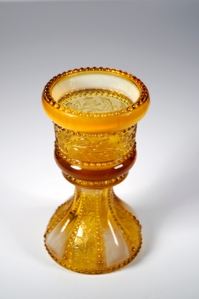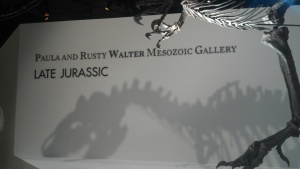Text by Amanda Dyer, Assistant Director
Come to the Table showcases American pressed glass in the Forsyth Galleries permanent collection from the American Victorian period, which coincided with the height of the product’s manufacture in the United States. In their earliest designs, pressed glass pieces mimicked the opulent cut glass that was used in the homes of wealthy Victorians. But because pressed glass was much less expensive to make, it was affordable to the middle-class, and pressed glass tableware came to be very popular in middle-class and upper middle-class American homes.

History of Pressed Glass Through the early 20th Century
Although ancient Romans first pressed glass into molds, mechanized pressed glass was first developed in the United States in the early 1800s. The creation of a successful machine press mold was the result of a series of patents, testing, and gradual improvements over the course of a decade, approximately 1820-1830. While the first notable patent for machine-made pressed glass was granted to Henry Whitney and Enoch Robinson of the New England Glass Co. in 1826, the development of the end product was truly an industry-wide effort. The basic pressed glass process involves a blob of hot glass being dropped into a mold, after which a plunger enters the top of the mold, forcing the glass into the mold’s crevices.
Pressed glass proved to be a very lucrative product for many glass factories, because much less expensive unskilled labor could be used to run the mold presses, and because producing thousands of copies of identical pieces made intricate molds more economical. Like factories of other types, glass factories were traditionally situated near fuel, raw materials, and transportation (at first rivers, and later, railroads). The earliest center of pressed glass production was the glassmaking hub of eastern Massachusetts. But the area where eastern Ohio, western Pennsylvania and northern West Virginia meet later became the nexus of the pressed glass industry upon improvements in transportation and the development of the area’s coal industry.

During the earliest years of mass-production, pressed glass was designed to replicate the styling and design of intricate cut-glass pieces, enabling middle-class citizens to afford pieces similar to their wealthier counterparts. While pieces were first mostly sold on an individual bases, by the 1840s factories were creating entire sets of patterned tableware, appealing to the middle-class desire to mimic the conspicuous consumption (the spending of money to acquire goods to display accumulated wealth) of the well-to-do. Manufacturers encouraged this practice by producing enormous tableware sets that included such absurdly specific items as honey dishes, mustard jars and marmalade jars, as well as toddy glasses, claret glasses, cordial glasses, wine glasses and champagne glasses, just to name a few. This trend continued through the earliest part of the twentieth century, coinciding with the American Victorian period.
Forsyth Collections Highlights

Bellflower
After the early convention of copying cut glass patterns in pressed glass, the aesthetic turned to more charming, slightly understated patterns. One of the most popular of these patterns was Bellflower (aka Ribbed Leaf), which included a finely ribbed body overlaid with simple bell-shaped flowers, leaves and berries. Similar patterns were also produced, including Ribbed Acorn, Ribbed Grape, and Ribbed Ivy. Scholars consider Bellflower to be the first pattern produced in enough separate pieces to be considered a tableware “set.” This pattern was produced in both a single-vine and double-vine design, and dozens of design variants can be found in existing pieces. Because of these many variants, and because of pattern fragments found at the glass factory sites, it is believed that Bellflower was made by many different factories from approximately 1850 to 1870. However, the only documented evidence of a specific factory manufacturing Bellflower is contained in catalogs distributed by McKee & Brothers of Pittsburgh ca. 1864. The Runyon Collection contains over 170 pieces of this particular pattern, which can be seen both on the luncheon table and in a vitrine in the exhibition.
Amberette

The Amberette pattern, produced c. 1898 by the Dalzell, Gilmore and Leighton Glass Co., in Findlay, Ohio, was also known during its
production as English Hobnail Cross, Alaska, and 75 or 75D. The pattern includes a frosted glass ground, with a faceted cross pattern. In some cases, as in the examples in the Runyon Collection, the cross pattern is tinted an amber color. The pattern was also offered in versions with clear glass and with ruby-tinting instead of amber. A report in a January 1898 issue of China, Glass and Lamps called the ware “probably the most original and unique in design of any shown this season.” Later collectors have called the pattern Klondike, perhaps because of the earlier Alaska designation.
